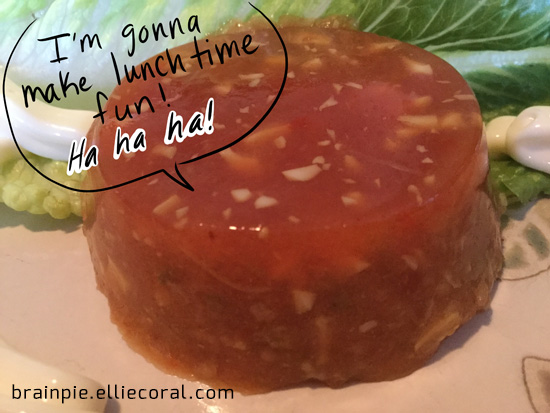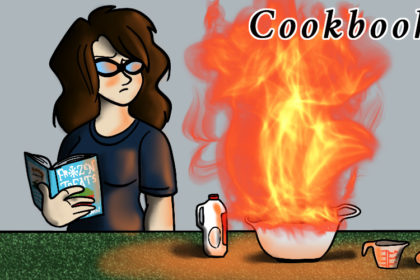Earlier this year, I’d scored a few cookbooks on one of my occasional trips to the Virginia Beach Antique Mall. By far the most interesting among these was Mary Meade’s Magic Recipes. The cover alone compelled me to buy it. Blending magic in cooking? Quaint! Visions of snarky blog posts danced through my head. I’d have material to last a year or until I got bored and turned to reviewing diet food on YouTube.
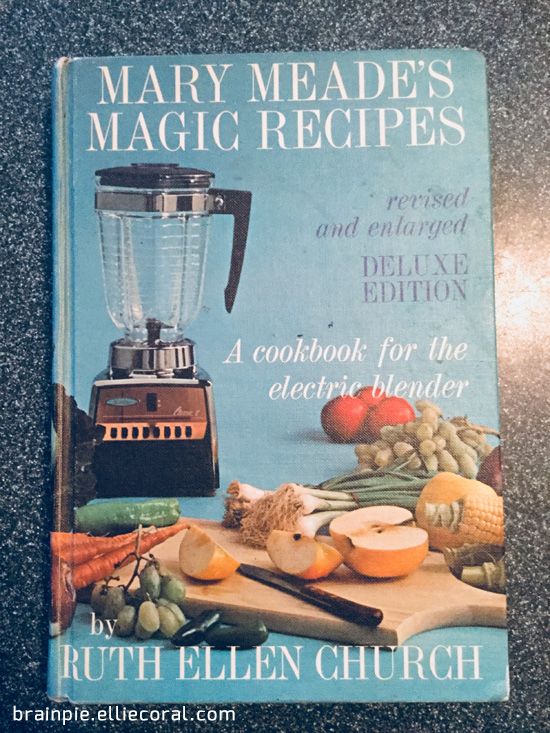
But as I skimmed the book, I realized that the author had some clever ideas. Chicago Tribune readers from the 1930s to the 1970s knew Mary Meade as both this fictitious name and her real one, Ruth Ellen Church. As a food editor, she began the country’s first newspaper wine column, transforming the then stuffy nature of wine connoisseurship into something the average American could enjoy. Over the course of her long career, she published six cookbooks and won six Vesta awards for excellence in food journalism. Probably the coolest thing I think she accomplished was a three-month adventure through Europe for a series called “What’s Cooking in Europe” that ran in the Tribune for fifty-six days. She was such an influence that when she retired in 1974, the name Mary Meade—which she had inherited from four previous women at the Tribune—retired with her.
The lady lived the dream! I Googled Mrs. Church, hoping to find out what happened to her after her colorful career. The first result was from an obituary in the New York Times. Ruth Ellen Church, 81, Food Critic and Author. Wow, eighty-one years old. She’d lived a long life…

Oh, my God.
Learning this news sent me reeling. That the criminal—who also robbed and harmed other people that night—was captured brought little comfort. Such an amicable and accomplished woman meeting a violent end, fading into obscurity over the decades… Mrs. Church deserves better.
As part of my personal mission to become a better cook, I’m going to hunt for the other writings of Ruth Ellen Church. But the best way to honor her is to make her food. In fact, I can’t wait to get started. I’ll open up the Magic Recipes book and point to my first Church recipe to make…
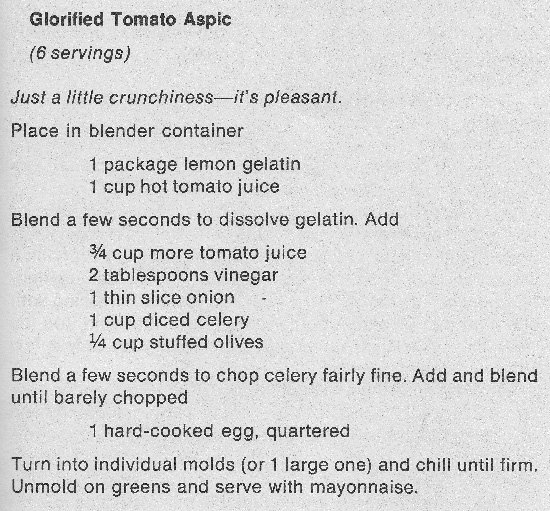
… and I’m in trouble already.
With all due respect, Mrs. Church, we have differing opinions on the definition of pleasant. You’ll have to forgive me, reader. See, there was a period during the early 2000s when comedy websites explored bizarre cuisine from decades past. Readers laughed at the horrors of combining tuna and clear gelatin. We shivered when brave comedy writers dared to mold fish out of olives and cucumbers. But most importantly, we sighed in relief when we were reminded that we didn’t live through such dark times. (Those of us born after the 1970s, anyway)
Those articles stayed with me. I’m ashamed to admit that they cultivated in me a special kind of food prejudice. But I pride myself on being an enlightened woman.
Gelatin in its many forms, including the reviled aspic, has a long history going back centuries. In the beginning, it could have been served as part of the main course or a means to preserve meats. It’s a versatile additive.
But to me, gelatin means dessert; it means jiggly, vaguely fruit-flavored squares; it means a way to get rid of nasty soda you can’t bring to pour down the sink; it means that odd charcoal peel I’m never trying again because what the hell was I thinking?
Enough stalling. Let’s dive in and brave this part of 1960s cuisine.

First up, let’s introduce my barely used kitchen gadget, the bold and brassy blender. I haven’t used Mr. Oster in probably over a year because I’ve been disappointed in the way he blends stuff. I should probably get a real food processor someday, but he doesn’t take up that much room in the cabinet, and space is at a premium in my current residence.
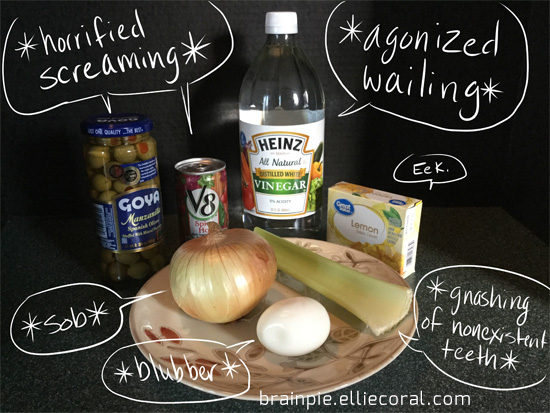
Second up, the unfortunate players in this tragedy. We have our spicy tomato juice (V8), lemon gelatin, vinegar, onion, celery, stuffed olives, and a hard boiled egg. Why spicy V8? Why not? Let’s live a little and make this especially challenging to eat.
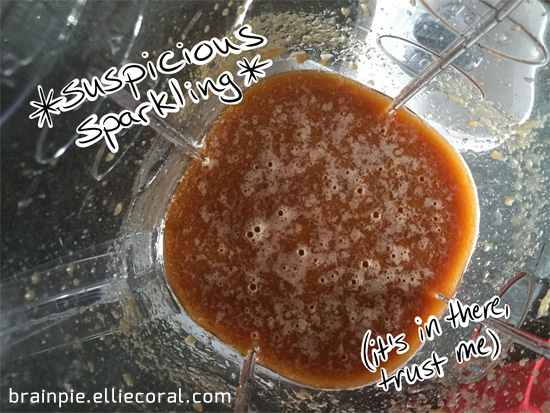
Place in blender container 1 package lemon gelatin and 1 cup hot tomato juice. Will do. It’s already looking shimmery, what with the suspiciously non-dissolved gelatin. Maybe some more blending will take care of that as we toss in everything else.
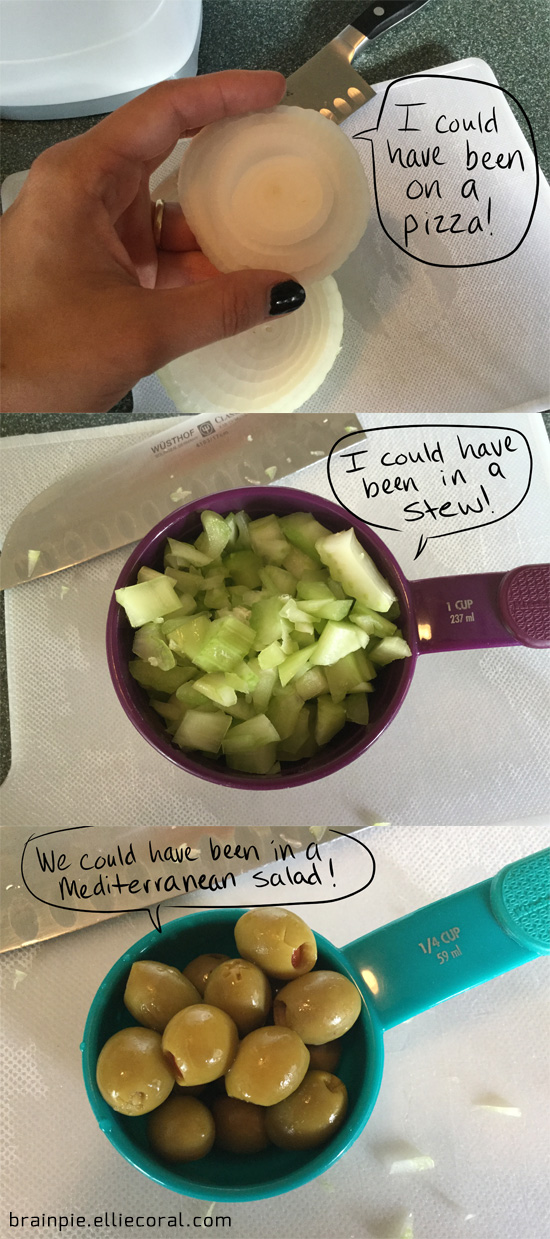
Yeah, yeah, in you go.
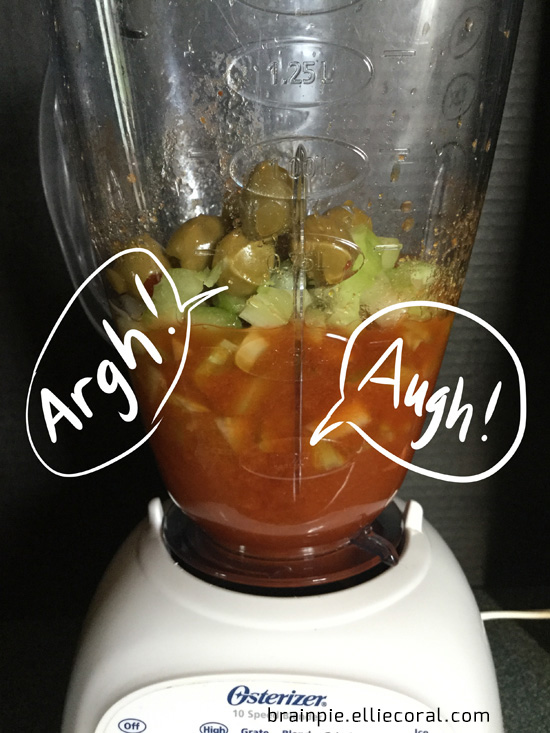
It looks so… scrumptious.
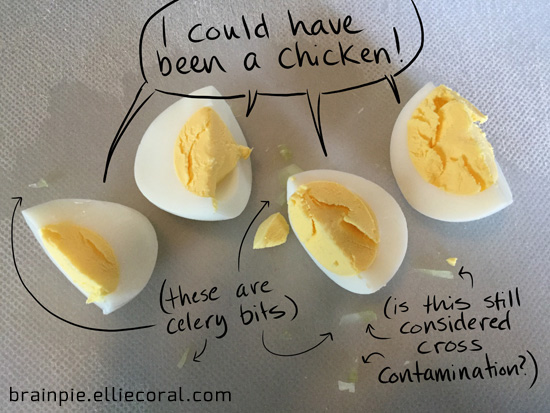
Add and blend until barely chopped 1 hard-cooked egg, quartered. It doesn’t smell too bad. It has the aroma of a deviled egg, which is one of my favorite snacks. Still looks awful, though.

I decided to be clever and use brain-shaped molds. To match the blog’s title and all that. These are meant for ice, and the little brain ice cubes are indeed cute and detailed. I can’t think of a better formation for tomato aspic than a brain.
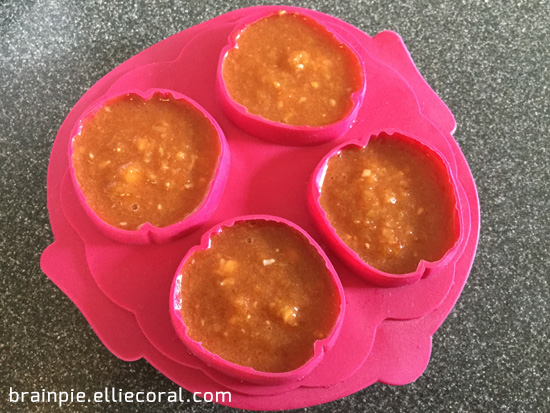
Into the fridge went the molds. I checked in several hours later to discover…
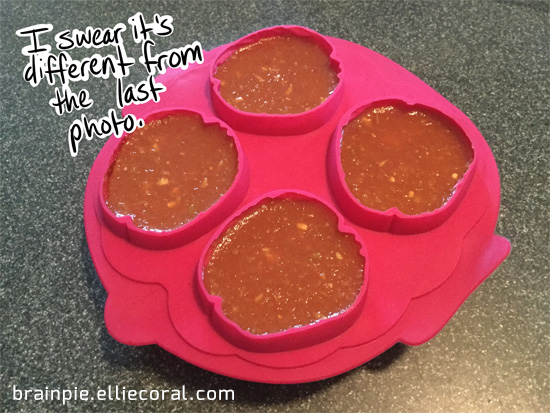
… that it hadn’t set. Tilting the mold tray made the contents slurp around the edges like a chunky stew. Crap. The gelatin hadn’t dissolved.
No worries! I was sure I could fix it. I poured everything into a microwave safe dish and nuked it for two minutes. Afterwards, I stirred the hell out of the mixture and poured it back into the brains. I left it alone overnight, hoping for the best.
You know you’re dedicated to a cooking project if you wake up at 5 am and run downstairs to check up on it. Like looking for evidence of Santa Claus being around. A 60s dinner party cooking Santa that leaves aspic dishes and… okay, that one’s going nowhere.
I tilted the mold. Nothing slid. I tapped a brain. The contents jiggled.
Success!… until I tried to take an aspic brain out.
It tore apart and collapsed onto the plate. I tried another one, hoping to get an intact specimen. None of them came out whole. Nothing had worked. My clever “this is your brain on 60s dinner party foods, any questions?” joke would never be realized. Instead of a cute and disturbing mold, I’d made chunky V8.
Oh, no. I’d have to start over. I’d have to go out to the store and get more ingredients. And interact with people on my day off.
This was kind of a struggle for me. Tempted though I was to throw out everything, I detest wasting food unless it’s absolutely necessary. I resolved to use the botched aspic for my lunches in the coming week, albeit in small servings. Maybe mix them with some other vegetable juice. Besides, the cotton rats living by the bird feeder wouldn’t eat aspic, and I’m sure such an act would be considered animal abuse.

A short trip to Food Lion later (the cashier was mercifully nongabby), I had actual tomato juice, lemon gelatin, and a dozen eggs. I set to work boiling six of the eggs (why waste all that water on only one?) and preparing the rest of the recipe. This time, I boiled the hell out of the tomato juice. The handle of the glass measuring cup was hot to the touch. There was no way the gelatin wasn’t going to dissolve this time.
Fast forward: Blah, blah, celery and onion and olives protesting their fates, blah, blah. Whip it all up. Throw in my impressively boiled egg. Whip it up again. Pray to the kitchen gods that this turns out right. Pour it into boring silicone muffin molds. Put in fridge. Go play Super Mario Odyssey.
Several hours later, I returned to find deceptively solid-looking aspic molds. I prodded a silicone cup to test the contents’ solidity. I pressed into the side of one, peeling part of the aspic away from the mold.
Success! I’d made tomato aspic!
I’d made tomato aspic… Well, on to the rest of the directions.
Unmold on greens and serve with mayonnaise. Oh, God, do I have to?

I wasn’t sacrificing all my lunch lettuce to this experiment, so one romaine leaf was used. I tried being as artsy as possible with the mayo, creating strategic dipping areas in a half circle. Now for the moment of truth…
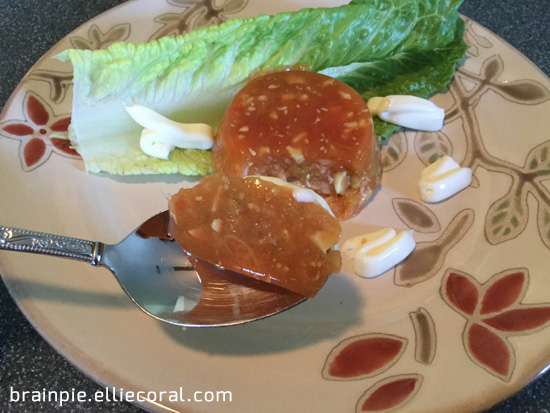
Are you guys ready for a shocker? It’s not half bad. The lemon flavor barely exists; I tasted more tomato than anything, with the occasional hint of olive, egg, or onion. Yes, there’s a crunch as promised. Best of all is that deviled egg fragrance still remains.
I could have taken the comedy website route and described it as the revolting offspring of a drunken encounter between tomato juice and lemon gelatin. Maybe for some it would be like that, but this is like a solidified form of V8 with some chopped vegetables tossed in for crunch. The lemon gelatin adds a slightly sour tang to the whole mix, but I can’t decide if I appreciate it or don’t care for it. I guess I’ll find out after a week of eating the stuff.
But on a serious note, this was kind of fun. Frustrating at times, but fun. I’m already looking for more recipes to use with my blender to turn it into the indispensable tool Mrs. Church believed it to be. I hope that in my odd way I made her proud and that this post gets more people interested in her work.
Now I have some tomato curdle and some actual molded aspic to eat. All by myself. I’m one lucky gal.
